Menu
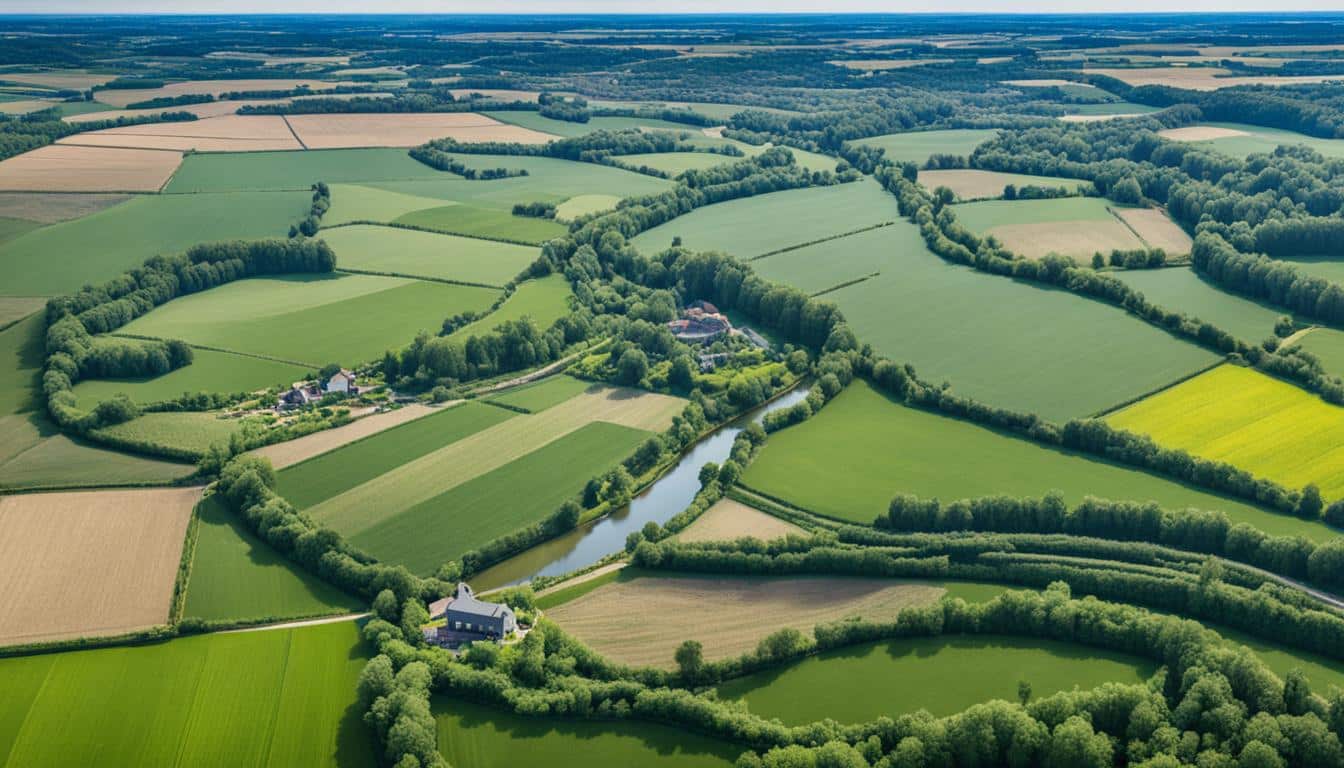
Did you know the U.S. Fish and Wildlife Service looks after 570 refuges across America? These are part of the National Wildlife Refuge System, aiming to protect native plants and animals. For farmers, this creates a complex challenge. They must balance making food with keeping our natural world safe. As new rules on protecting wetlands come out, it shows how vital and tricky farming and wildlife preservation are. In this piece, we will explore how farmers can meet these rules and still make a living.
Wildlife protection regulations are key to preserving nature on farms. In the United States, each state handles its own wildlife laws. For instance, Michigan and New York make their own wildlife rules. This is unlike places like China and India, where national laws control wildlife. Each state can then make its own plans to protect local wildlife.
The state ownership doctrine says states are mainly in charge of wildlife. This means states decide the rules on hunting and protecting wildlife. So, every state can manage its own conservation work. An important legal case, Geer v. Connecticut, underlined state power over wildlife use.
The US federal government steps in for international wildlife agreements and issues concerning federal lands. It works with states to make sure everyone is protecting wildlife well. This teamwork aims to cover all bases for wildlife safety.
Yet, state wildlife rules have limits. Indian treaties give some tribes special hunting and fishing rights. This means states must respect these rights. It shows how wildlife protection in the US is a team effort involving many laws and groups.
Biodiversity rules are key in today’s agriculture. They help keep a balance between farming and nature. The goal is to grow food without harming the environment that we rely on.
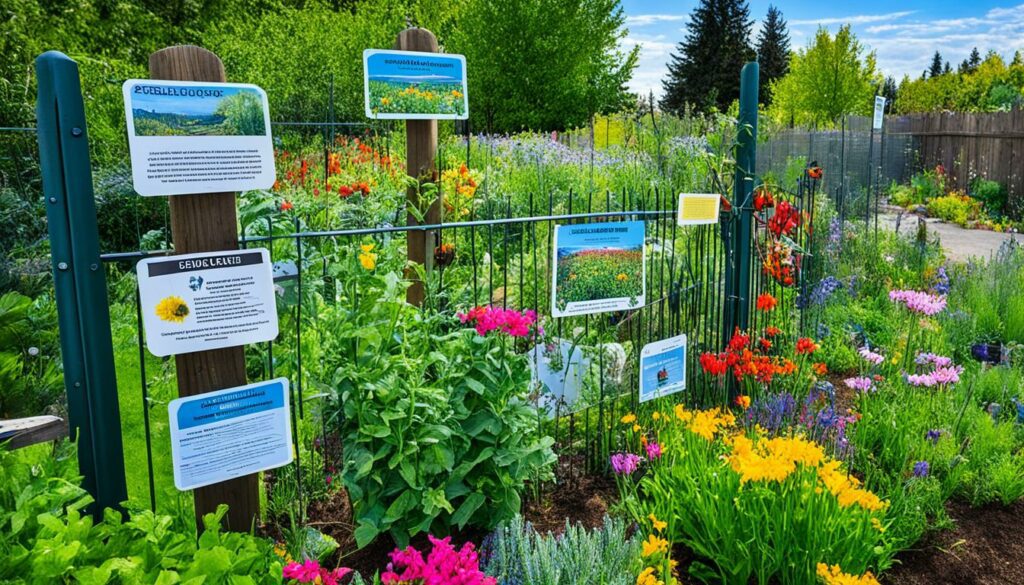
Having rules for biodiversity has many advantages. For instance, the UK’s farms are crucial for keeping nature in balance. By farming in ways that are gentle on the land, we can protect wildlife. Organic farming is a good example. It uses fewer artificial nutrients and helps local species.
Keeping some parts of farms natural is very important. Techniques like planting wide strips or beetle banks help animals. Healthy wildlife also means better farm yields. Fields with areas set aside for wildlife can produce just as much as fully farmed ones.
Farmers find it hard to meet biodiversity rules. It can be tricky to farm productively while protecting wildlife. The laws can seem complex and hard to follow.
But, following these rules can actually save money and make farms work better. Approaches like wildlife-friendly farming need good planning. They bring huge benefits over time.
Using fewer chemicals is good for the land but requires more effort. It also keeps our waters clean. Though it’s a lot of work, it’s worth it for the environment and the farm’s health.
| Practices | Benefits | Challenges |
|---|---|---|
| Organic Farming | Increases wildlife populations | More labour-intensive |
| Vegetation Buffer Strips | Reduces pollution, enhances habitat diversity | Requires proper establishment and maintenance |
| Wildlife Land Sparing | Improves biodiversity and crop yields | Initial setup costs |
Biodiversity rules are crucial for farms. Yes, farming sustainably is hard, but it’s essential for our future. By following these guidelines, we can make agriculture both stronger and kinder to our planet.
In today’s world, we must care for our environment. This means using sustainable farming practices that help wildlife and our farms. Following the rules for farming and protecting wildlife ensures our farms stay healthy. It also keeps the land around us vibrant.
One good way to farm sustainably is through rotational grazing. This method moves animals between different pastures. It stops them from eating too much, which might harm the soil and plants. The Grassland Reserve Program (GRP) is key in saving good grazing lands. This helps protect natural homes for animals. Rotational grazing also cuts greenhouse gases by 42%. It reduces other bad pollutions too.
Restoring wetlands is also important for our farms and wildlife. It does more than give animals a place to live. Wetlands are crucial for holding water and keeping our ecosystems healthy. The Farmable Wetlands Program (FWP) turns farmlands back into wetlands. This meets the needs of wildlife under the law. It also stops erosion. It makes water cleaner and supports a wide range of plants and animals.
Using these sustainable ways in farming is not just about following rules. It’s about helping our planet in big ways. It keeps our farms and nature in balance. This ensures a brighter world for those who come after us.
| Programme | Acres Conserved | Key Benefits |
|---|---|---|
| Conservation Reserve Program (CRP) | 36 Million | Wildlife habitat preservation |
| Conservation Reserve Enhancement Program (CREP) | 4.7 Million | Targeted high-priority conservation issues |
| Farmable Wetlands Program (FWP) | Substantial | Wetland restoration and plant cover |
| Grassland Reserve Program (GRP) | Substantial | Protection of grazing lands and natural habitats |
The story of wildlife protection laws on farms starts with big steps in the early 1900s. The Lacey Act of 1900 stands out as the first federal law on this. It banned moving wildlife across states if they were killed against state laws.
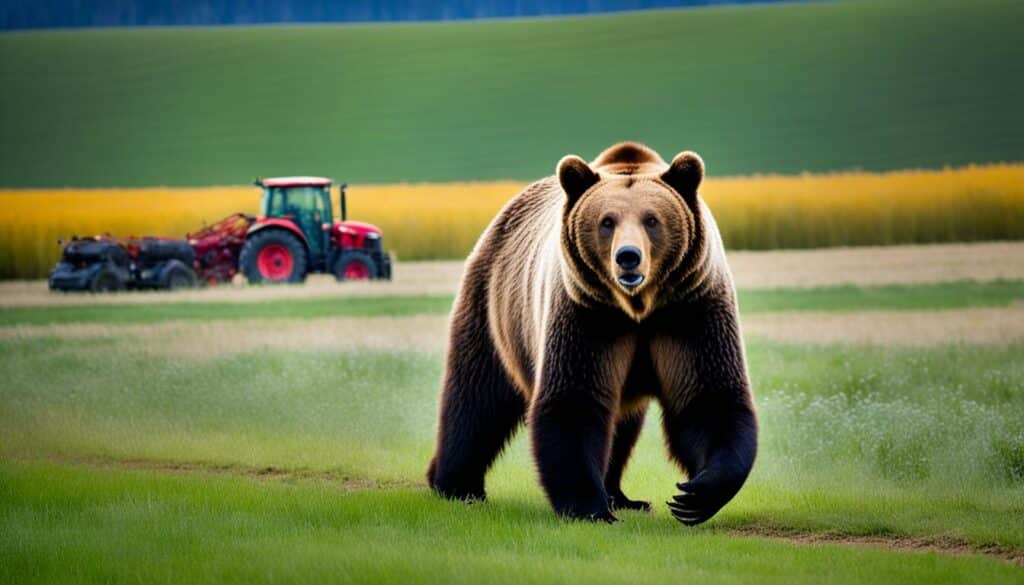
In the 1930s, the Tariff Act of 1930 added more power to the Lacey Act. It said people couldn’t bring in birds or mammals killed illegally in other countries. This showed a growing interest in caring for nature all around the world.
Then, in 1903, President Roosevelt set up the Pelican Island National Wildlife Refuge. This was the first step towards making safe places for wildlife to live.
The Migratory Bird Treaty Act (MBTA) of 1918 was a big deal. It was tough on people hunting migratory birds. With this law, the government showed it was dead serious about protecting nature.
Later in 1916 came the National Park Service Act. It started what would become many national parks and safe areas for wildlife. This was a major win for nature protection.
Fast forward to the 1960s, and people were getting worried about pollution. The focus then became about keeping the environment clean and safe for animals.
Another key act was the Bald Eagle Protection Act. It was backed by a special element in the nation’s laws. Its roots go back to the 1930s efforts to keep bald eagles safe.
The courts also played a role in protecting wildlife. Cases like Thornton v. United States in 1926 helped in this. They made sure laws about wildlife protection were solid.
In the end, the journey of making laws to protect wildlife in farming is about moving forward. Many important acts and policies have led us to where we are now in protecting nature.
Wildlife protection rules in farming have big effects. They change how farmers work. Yet, they also help our planet. Knowing these changes helps farmers protect nature while producing food.
These rules can cost farmers a lot. For example, many animals are kept in small spaces. This means farmers may need to build bigger and kinder places for them. But these changes can be expensive.
On the bright side, the government might help with money. Many groups want to support farmers doing the right thing. This includes the Farm System Reform Act. It aims to help farmers who are farming in ways that are good for nature.
These rules help the environment a lot. They can mean less pollution and more healthy places for plants and animals. This is important because many people worry about big farms causing pollution.
Using special farming ways, like grazing and fixing wetlands, can make nature better. It helps more kinds of plants and animals to live.
Also, farming less intensively can help stop sickness passing between animals and humans. This is making farming and looking after nature work well together. It promises a future where farming helps nature thrive too.
Farmers need to know about important policies in conservation. The National Wildlife Refuge System and state rules are big parts of this. They help farmers grow crops and take care of the environment around them.
The U.S. Fish and Wildlife Service started the National Wildlife Refuge System. It protects fish, wildlife, and plants by saving certain lands and waters. This system helps make sure there are good habitats for different plants and animals.
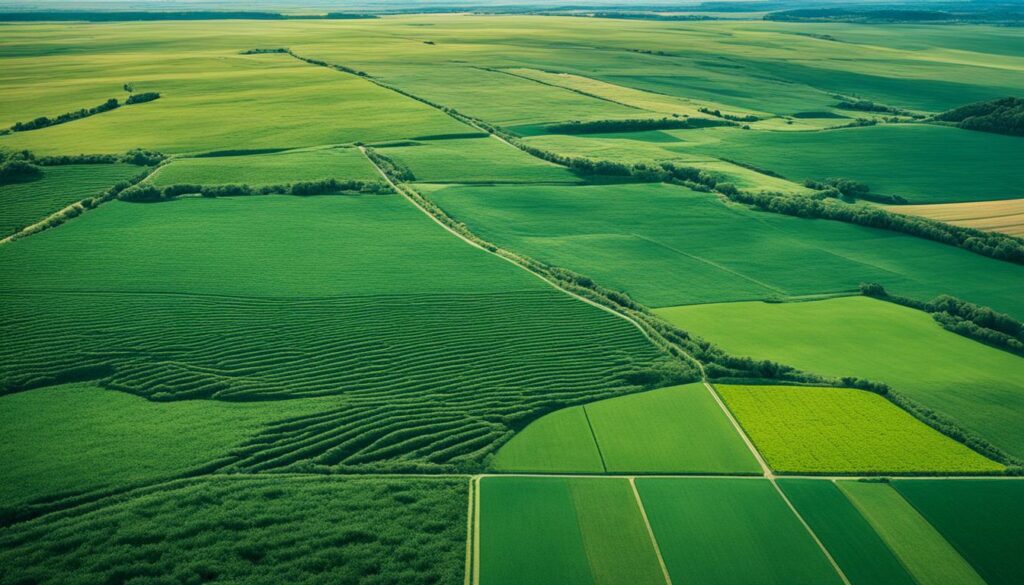
Federal schemes like the Agricultural Conservation Easement Program and the Conservation Reserve Program mix farming with saving nature. These projects pay farmers to use their land in ways that help nature, like planting more trees. This keeps the environment healthy and farms working well.
Local and state rules are as important as national ones for farm conservation. They give money and advice to farmers through groups that take care of land and water. This support helps farmers make their farms more friendly to nature.
State groups for nature and farming work hard to oversee conservation plans that fit local needs. The Environmental Quality Incentives Program is a plan that gives farmers both money and advice. It helps them manage their farms in ways that keep the soil, water, and plants healthy.
Following these rules makes farmers help save nature while they grow food. They not only follow the law but also keep the environment healthy. This way, they make sure farming is good for both crops and nature.
Conservation agencies and farmers must work together to protect wildlife in farming. They help ensure farming is sustainable. At the same time, they preserve ecosystems important for our plants and animals.
The USDA is putting over $500 million into protecting wildlife over the next five years. Half of this money is from the ACEP. The rest is from the EQIP. With $40 million going to save big game paths in the west U.S., and $14 million set for bobwhite quail in the east.
Thanks to programs like WLFW, almost 12 million acres of land have been saved since 2010. More than 8,400 farmers and scientists have worked on this. They show just how important it is for everyone to team up. An extra $30 million is also going into making WLFW even stronger.
Some places, like Marin County, work with farmers and conservation groups to protect both livestock and wildlife without using deadly ways. Others, such as Project Coyote and the Snow Leopard Conservancy, test how to live alongside predators harmlessly. This helps both farming and wild animals thrive together.
Ranchers in some places use guard dogs to help protect their animals without hurting native predators. They share their knowledge in events where they talk about how farming can also support wildlife. This shows that including wildlife can be good for everyone involved and for nature.
Good brush management is key for better wildlife habitat and biodiversity on farms. It helps keep a good mix between farming and nature. This balance is crucial for a healthy environment.
The main aim of brush management is to boost food and homes for animals. Well-done management can raise the number of plant types and make the land healthier. Removing the right amount of brush in the right way keeps needed wildlife shelter. For example, using strip or mosaic patterns helps keep hiding spots for animals.
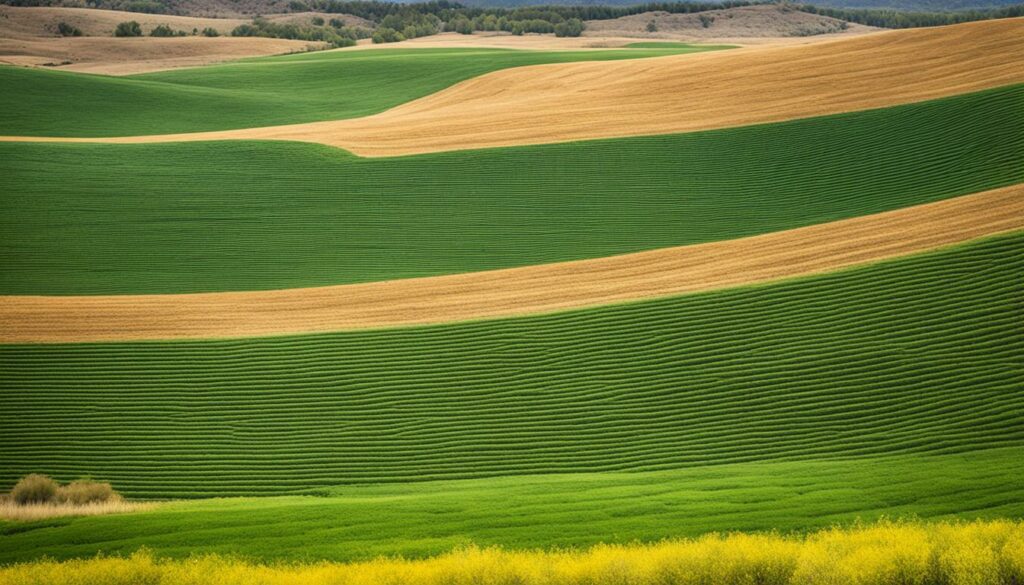
Different methods, like machines or controlled fires, bring different good effects. Machines can help certain trees grow back, which animals like to eat. Fire can boost soil health and help plants animals love. These methods are all part of good wildlife management.
Managing brush also helps more plant types grow. Clearing out some trees lets other plants have more water and food. This leads to a wider mix of plants. And that draws in more kinds of animals. It’s also important to clear the land without pulling up the soil, especially in places where the soil could easily wash away.
Helping wildlife is also good for the economy. In the U.S., over a third of private land is used for fun wildlife activities. People spend a lot of money on this, like nearly a billion dollars a year for hunting fees. Watching wildlife also gets nearly 300 million dollars in spending.
Since wildlife responses can be complex, we need unique plans for each area. The weather, types of plants, how we treat the land, and even how long it’s been since we acted all matter. Better talks between those who manage the land and those who use it are key. They help make sure wildlife of all kinds have what they need.
Improving the structure of forest stands helps support sustainable timber production. It also aids in the growth of mixed-age forests. This effort is backed by the Conservation Reserve Program (CRP). Also, the Forest Management Incentive, run by the Farm Service Agency (FSA), gives money to those who work on their forests.
Well-kept forest stands lead to steady timber output. The Forest Management Incentive helps with tasks like managing brush, controlling herbaceous weeds, and doing controlled burns. These actions improve timber yields and quality. They also help the economy by using forest resources well.
Developing mixed-age forests is crucial for forest stand enhancement. These forests have trees of various ages. This setup boosts biodiversity and makes the ecosystem more resilient. It’s good for wildlife and strengthens the forest against harsh conditions. A successful approach balances timber needs with caring for nature.
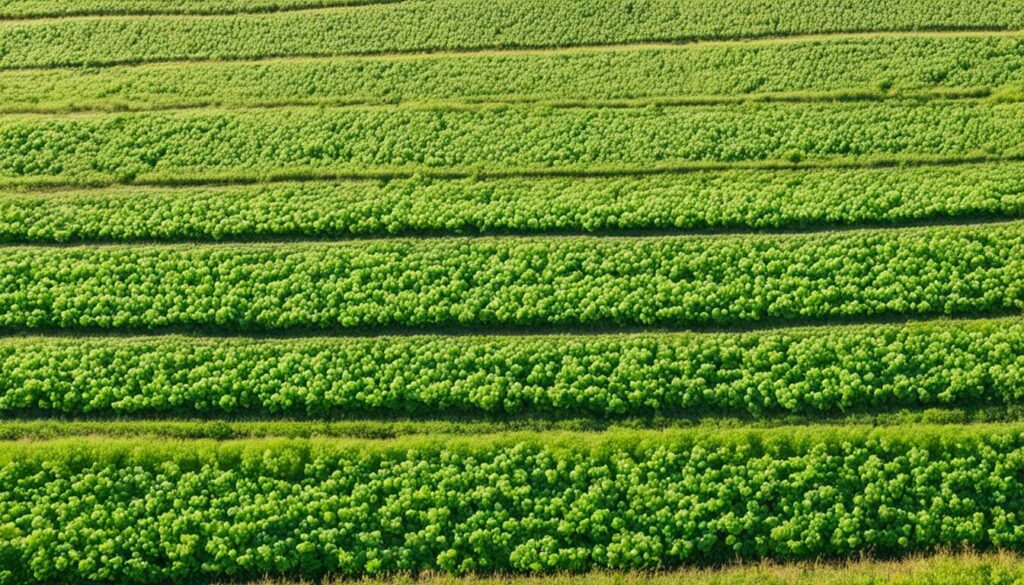
Successfully balancing farming productivity and wildlife protection is key. Farming needs to change to meet these goals. Farmers must use methods that keep the soil healthy and help wildlife.
These methods reduce costs and boost profits. They also help wildlife and pollinators by creating better habitats. By doing so, we can save money and make farming better for everyone.
“On-farm conservation can sustain agricultural productivity while achieving a range of environmental benefits.” USDA’s programs, like ACEP, CSP, and EQIP, offer support to farmers who want to protect the land. This help makes it easier to follow wildlife protection rules and keep farming innovating.
USDA also runs programs like CRP and CREP, which are vital for land protection. These help lessen harm to the environment and keep the land healthy. Almost half of the U.S. is private farmland. Thus, it’s essential to adapt farming to protect our land.
The NRCS Climate Center offers vital climate and land information to farmers. This helps them manage their land sustainably. Organizations like NSAC support federal policies for better farming. Programs like CSP and EQIP are important for protecting our natural resources.
To follow wildlife protection rules, farmers must meet conservation standards. This means looking after the soil and not harming protected land. The Sodsaver provision is one rule that helps in this. It makes sure farmers don’t harm native prairies.
Changing how we farm to save wildlife is a win-win situation. It helps both farmers and the environment. By using the support available and making changes, we can have a bright farming future. This shows how important it is to use what we have and adopt good farming practices for all.
Farmers need to know about the financial help available. This is if they want to follow wildlife rules. Many programmes give money and advice. They make it easier for farmers to keep up their land while protecting nature.
Government funds and grants are important for farmers. The CRP gives money to farmers who stop farming sensitive land. In 2023, it gave out over $1.77 billion to help over 667,000 farmers protect 23 million acres.
The ECP fixes farmland hit by disasters. The FWP pays for restoring wetlands to help the environment.
Conservation experts help farmers technically. The SWPP protects water. It helps people in the countryside by making sure their water is clean.
The GRP stops grazing areas becoming something else. It pays farmers to keep these lands natural.
Below is a table showing more about these programmes:
| Program | Description | 2023 Enrollments | t
|---|---|---|
| Conservation Reserve Program (CRP) | Pays for environmentally sensitive land removal and environmental quality improvement | 24.8 million acres | t
| Emergency Conservation Program (ECP) | Provides funding and technical assistance for farmland damaged by disasters | — | t
| Farmable Wetlands Program (FWP) | Annual rental payments for wetland restoration and plant cover | — | t
| Grassland Reserve Program (GRP) | Prevents conversion of grazing lands to cropland or urban use and offers rental payments | 2.3 million acres | t
| Source Water Protection Program (SWPP) | Protects surface and ground waters used as drinking water by rural residents | — | t
Funding and support are essential for farmers. They help farmers meet conservation goals. This keeps their farms going strong for years.
Looking back at wildlife protection rules in farming, we see a long history of conserving nature. These efforts have changed how we farm today. In the U.S., Michigan stood out by hiring a game and fish warden on March 15, 1887. This was a big step, making wildlife protection in farming more detailed and effective.
An important law, the Lacey Act, was put into action in 1900. It was the first law in the U.S. to protect wildlife. Then, in 1903, Pelican Island National Wildlife Refuge was created by President Roosevelt. This showed a big commitment to saving nature and was the start of many wildlife refuges. The Migratory Bird Treaty Act of 1918, signed with Great Britain, made even more nations work together to protect birds.
In the 1930s, protecting wildlife became even more key in farming. In 1934, important laws like the Migratory Bird Hunting and Conservation Stamp Act were added. Others included the Bald Eagle Protection Act and the Taylor Grazing Act. These rules helped farms and wildlife to share the land better. Even recent laws like the Animal Damage Control Act of 1931 and the EU’s Common Agricultural Policy show the ongoing work to farm in a way that’s kind to wildlife and nature.
The EU’s Common Agricultural Policy has brought real change, with €104bn spent between 2014 and 2020. This money went to actions that help the climate, leading to a big drop in emissions. The CAP helps with a lot, like saving water, stopping soil erosion, and supporting organic farming. These steps show farming can help fight climate change, aiming to reach zero greenhouse gas emissions by 2050.
Farming faces rules from acts like the Wildlife and Countryside Act 1981. Also, the Conservation of Habitats and Species Regulations 2017 is key. They protect habitats, rare species, and push for more biodiversity through farming practices.
Knowing these rules helps make farming activities eco-friendly. It ensures farming does not harm wildlife while being productive. It’s important for avoiding fines and getting help or funding.
Saving biodiversity on farms makes ecosystems healthier. It boosts soil health, controls pests naturally, and makes farming stronger. These are crucial aspects of both wildlife protection laws and eco-friendly farming.
Farmers find it tough to start new, eco-friendly methods due to costs. They need to learn how to farm sustainably and deal with complex rules. Overcoming these issues is key for following wildlife protection laws.
Rotational grazing keeps plant cover, stops soil erosion, and encourages different plants. It helps wildlife habitats. These practices are vital for farming in line with wildlife laws.
Restoring wetlands helps manage water better. It makes more homes for different plants and animals. It also helps reduce carbon. These practices fit well with farm conservation and eco-rules.
Laws have moved from basic nature protection to bigger plans for ecosystem care. They focus on saving species and have clearer rules. These changes make today’s and tomorrow’s laws on nature.
Following wildlife laws can cost at first but leads to better farming and benefits in the long run. It helps get support and makes farming more sustainable.
These rules help keep nature diverse, improve soil, cut pollution, and maintain ecosystems. They match up with saving nature and are key for green farming.
The U.S. Fish and Wildlife Service runs the National Wildlife Refuge System. It’s to save wildlife places all over the U.S. Farmers nearby must follow certain rules to protect these areas.
Local and state rules help save nearby nature and guide how land is used. They also push for farming that’s good for the planet. Farmers must keep up with these laws.
Working with green groups gives farmers help, funds, and tips for better farming and nature. It’s good for farms and helps save wildlife.
Looking after places with bushes creates more homes for wildlife. It stops bad plants, grows good ones, and provides cover and food. This helps follow green farming rules and makes homes for wildlife better.
Making more kinds of life in nature keeps ecosystems steady, helps against climate change, and saves species. These are top goals of green laws and good for farming too.
Making forests healthier helps them grow wood well without hurting the land. Picking trees wisely and mixing their ages is good for both cutting wood and saving nature.
Forests with all ages are great for many animals, fight off bugs and sickness, and last a long time. It’s a strong move for saving forests and caring for wildlife.
To follow green laws, try changing how you farm. Use crop changes, less chemical, and look after the earth. Keeping up with new farming guides and talks with nature groups is important.
There’s money and help for doing eco-friendly farming right. Things like EQIP and advice from green groups can cut costs and give you smarter ways to farm.
Through programs like CRP, farms give back to nature by fixing living spaces. Using buffer strips keeps water clean. These show real ways to care for nature while farming.